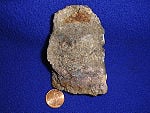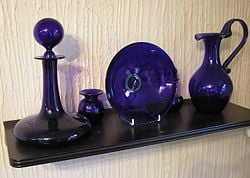Cobalt
 From Nwe
From Nwe
|
|||||||||||||||||||||||||||||||||||||
| General | |||||||||||||||||||||||||||||||||||||
|---|---|---|---|---|---|---|---|---|---|---|---|---|---|---|---|---|---|---|---|---|---|---|---|---|---|---|---|---|---|---|---|---|---|---|---|---|---|
| Name, Symbol, Number | cobalt, Co, 27 | ||||||||||||||||||||||||||||||||||||
| Chemical series | transition metals | ||||||||||||||||||||||||||||||||||||
| Group, Period, Block | 9, 4, d | ||||||||||||||||||||||||||||||||||||
| Appearance | metallic with gray tinge  |
||||||||||||||||||||||||||||||||||||
| Atomic mass | 58.933195(5) g/mol | ||||||||||||||||||||||||||||||||||||
| Electron configuration | [Ar] 3d7 4s2 | ||||||||||||||||||||||||||||||||||||
| Electrons per shell | 2, 8, 15, 2 | ||||||||||||||||||||||||||||||||||||
| Physical properties | |||||||||||||||||||||||||||||||||||||
| Density (near r.t.) | 8.90 g/cm³ | ||||||||||||||||||||||||||||||||||||
| Liquid density at m.p. | 7.75 g/cm³ | ||||||||||||||||||||||||||||||||||||
| Melting point | 1768 K (1495 °C, 2723 °F) |
||||||||||||||||||||||||||||||||||||
| Boiling point | 3200 K (2927 °C, 5301 °F) |
||||||||||||||||||||||||||||||||||||
| Heat of fusion | 16.06 kJ/mol | ||||||||||||||||||||||||||||||||||||
| Heat of vaporization | 377 kJ/mol | ||||||||||||||||||||||||||||||||||||
| Heat capacity | (25 °C) 24.81 J/(mol·K) | ||||||||||||||||||||||||||||||||||||
|
|||||||||||||||||||||||||||||||||||||
| Atomic properties | |||||||||||||||||||||||||||||||||||||
| Crystal structure | hexagonal | ||||||||||||||||||||||||||||||||||||
| Oxidation states | 2, 3 (amphoteric oxide) |
||||||||||||||||||||||||||||||||||||
| Electronegativity | 1.88 (Pauling scale) | ||||||||||||||||||||||||||||||||||||
| Ionization energies (more) |
1st: 760.4 kJ/mol | ||||||||||||||||||||||||||||||||||||
| 2nd: 1648 kJ/mol | |||||||||||||||||||||||||||||||||||||
| 3rd: 3232 kJ/mol | |||||||||||||||||||||||||||||||||||||
| Atomic radius | 135 pm | ||||||||||||||||||||||||||||||||||||
| Atomic radius (calc.) | 152 pm | ||||||||||||||||||||||||||||||||||||
| Covalent radius | 126 pm | ||||||||||||||||||||||||||||||||||||
| Miscellaneous– | |||||||||||||||||||||||||||||||||||||
| Magnetic ordering | ferromagnetic | ||||||||||||||||||||||||||||||||||||
| Electrical resistivity | (20 °C) 62.4 nΩ·m | ||||||||||||||||||||||||||||||||||||
| Thermal conductivity | (300 K) 100 W/(m·K) | ||||||||||||||||||||||||||||||||||||
| Thermal expansion | (25 °C) 13.0 µm/(m·K) | ||||||||||||||||||||||||||||||||||||
| Speed of sound (thin rod) | (20 °C) 4720 m/s | ||||||||||||||||||||||||||||||||||||
| Speed of sound (thin rod) | (r.t.) 209 m/s | ||||||||||||||||||||||||||||||||||||
| Shear modulus | 75 GPa | ||||||||||||||||||||||||||||||||||||
| Bulk modulus | 180 GPa | ||||||||||||||||||||||||||||||||||||
| Poisson ratio | 0.31 | ||||||||||||||||||||||||||||||||||||
| Mohs hardness | 5.0 | ||||||||||||||||||||||||||||||||||||
| Vickers hardness | 1043 MPa | ||||||||||||||||||||||||||||||||||||
| Brinell hardness | 700 MPa | ||||||||||||||||||||||||||||||||||||
| CAS registry number | 7440-48-4 | ||||||||||||||||||||||||||||||||||||
| Notable isotopes | |||||||||||||||||||||||||||||||||||||
|
|||||||||||||||||||||||||||||||||||||
Cobalt (chemical symbol Co, atomic number 27) is a hard, lustrous, silver-gray metal. It is found in various ores and is important as a trace element in the human body. It is used in the preparation of wear-resistant, high-strength alloys, magnetic media, and battery electrodes. It is a catalyst for various chemical reactions and is useful for electroplating.
Cobalt compounds are used in the production of inks, paints, and varnishes. Its radioactive isotope cobalt-60 is used for radiotherapy, sterilization of foods, and detection of structural flaws in metal parts.
Occurrence
Cobalt is not found as a free metal but is generally found in the form of ores. It is usually produced as a byproduct of nickel and copper mining activities. The main ores of cobalt are:
- cobaltite - cobalt arsenic sulfide (CoAsS)
- erythrite - hydrated cobalt arsenate (Co3(AsO4)2•8H2O)
- glaucodot - cobalt, iron arsenic sulfide ((Co,Fe)AsS), in which the cobalt:iron(II) ratio is typically 3:1
- skutterudite - a cobalt arsenide mineral in which variable amounts of nickel and iron substitute for cobalt ((Co,Ni,Fe)As3)
The world's major producers of cobalt are the Democratic Republic of the Congo, China, Zambia, Russia, and Australia. It is also found in Finland, Azerbaijan, and Kazakhstan. In the town of Cobalt, Ontario, it is a byproduct of silver mining.
History and etymology
Cobalt compounds have been used for centuries to impart a rich blue color to glass, glazes, and ceramics. Cobalt has been detected in Egyptian sculpture and Persian jewelry from the third millennium B.C.E., in the ruins of Pompeii (destroyed CE 79), and in China dating from the Tang dynasty (CE 618–907) and Ming dynasty (CE 1368–1644).[1]
Swedish chemist Georg Brandt (1694–1768) is credited with isolating cobalt sometime between 1730 and 1737. He showed that cobalt was the source of the blue color in glass, which previously had been attributed to bismuth found with cobalt. During the nineteenth century, cobalt blue was produced at the Norwegian Blaafarveværket (70-80 percent of world production), led by the Prussian industrialist Benjamin Wegner. In 1938, John Livingood and Glenn Seaborg discovered the radioisotope cobalt-60.
The word cobalt is derived from the German kobalt, from kobold meaning "goblin." Miners used this term for the ore of cobalt, because they thought it worthless and found that it was poisonous and degraded other mined elements. The poisonous nature was mainly because of the presence of arsenic and sulfur in the ore.[2]
Notable characteristics
In chemistry, cobalt is a member of a group of transition metals. It is located in period four of the periodic table, situated between iron and nickel. In addition, it lies at the top of group nine (former group 8B). In combining with other elements, its common oxidation states are +2 and +3, but +1 is also seen.
Like iron, cobalt can be magnetized and converted into a permanent magnet. It is said to be "ferromagnetic." It loses this property when heated above 1388 K, which is called its Curie temperature.
Cobalt is frequently associated with nickel, and both are characteristic ingredients of meteoric iron. Mammals require small amounts of cobalt salts.
Metallic cobalt commonly presents a mixture of two crystallographic structures: "hcp" and "fcc." The transition temperature in going from hcp to fcc is 722 K.
Isotopes
Naturally occurring cobalt is composed of one stable isotope, 59Co. In addition, 22 radioisotopes have been characterized, of which the most stable is 60Co, with a half-life of 5.2714 years. Cobalt-60 is useful as a gamma-ray source partially because it can be produced—in known quantity and large amounts—by simply exposing natural cobalt to neutrons in a reactor for a given time. It is used as a radioactive tracer and agent for treating cancer.
Other radioisotopes include 57Co, with a half-life of 271.79 days; 56Co, with a half-life of 77.27 days; and 58Co, with a half life of 70.86 days. All the remaining radioisotopes have half-lives that are less than 18 hours, and the majority of these have half-lives that are less than one second. This element also has four meta states, all of which have half-lives less than 15 minutes.
The isotopes of cobalt range in atomic weight from 50 amu (50Co) to 73 amu (73Co). The primary decay mode before the most abundant stable isotope, 59Co, is electron capture and the primary mode after is beta decay. The primary decay products before 59Co are element 26 (iron) isotopes, and the primary products after are element 28 (nickel) isotopes.
Compounds
There is a wide variety of cobalt compounds. The +2 and +3 oxidation states are most prevalent, but cobalt(I) complexes are also fairly common. Cobalt(II) salts form the red-pink [Co(OH2)6]2+ complex in aqueous solution. Addition of excess chloride changes the color from pink to blue, due to the formation of [CoCl4]2-. Cobalt oxides are antiferromagnetic at low temperature: CoO is antiferromagnetic below its Neel temperature of 291 K, and Co3O4 is antiferromagnetic below its Neel temperature of 40 K. (In an antiferromagnet, the magnetic ions are all oppositely aligned, so that the net magnetization is zero.)
Applications
- Alloys, such as:
- Magnets and magnetic recording media.
- Alnico magnets.
- Catalysts for the petroleum and chemical industries.
- Electroplating, because of its appearance, hardness, and resistance to oxidation.
- Drying agents for paints, varnishes, and inks.
- Ground coats for porcelain enamels.
- Pigments (cobalt blue and cobalt green).
- Battery electrodes.
- Steel-belted radial tires.
- The isotope cobalt-60 has multiple uses as a source of gamma rays:
- Radiotherapy.
- Radiation treatment of foods for sterilization (cold pasteurization).
- Industrial radiography, to detect structural flaws in metal parts.
Use in medicine
The radioactive isotope cobalt-60 (Co-60 or 60Co) is used in radiotherapy. It produces gamma rays at two energy levels: 1.17 MeV and 1.33 MeV. The 60Co source is about two centimeters (cm) in diameter and as a result produces a geometric penumbra, which means that the edge of the radiation field is fuzzy. The metal has the unfortunate habit of producing a fine dust, causing problems with radiation protection. The 60Co source is useful for about five years, but even after this point it is still very radioactive. For these reasons, cobalt machines have fallen from favor in the Western world where linacs are common.
Biological role
Cobalt in small amounts is essential to many living organisms, including humans. The presence of 0.13 to 0.30 mg/kg of cobalt in soils markedly improves the health of grazing animals. Cobalt is a central component of the vitamin cobalamin, or vitamin B-12.
Precautions
Powdered cobalt in metal form is a fire hazard. Cobalt compounds should be handled with care due to cobalt's slight toxicity.
The radioisotope 60Co is a powerful gamma-ray emitter and exposure to it is therefore a cancer risk. Ingestion of 60Co leads to incorporation of some cobalt into tissues, which is released very slowly. 60Co is a risk factor in a nuclear confrontation because neutron emissions will convert 59Co into this isotope. Some nuclear weapons may be designed to increase the amount of 60Co dispersed in nuclear fallout. Such a weapon is sometimes called a dirty bomb or cobalt bomb, which a leading scientist predicted as being capable of wiping out all life on earth. The risk in the absence of a nuclear war comes from improper handling (or theft) of medical radiotherapeutic units.
See also
Notes
References
ISBN links support NWE through referral fees
- Cobalt Los Alamos National Laboratory. Retrieved December 11, 2007.
- Cobalt WebElements.com. Retrieved December 11, 2007.
- Cotton, F. Albert, and Geoffrey Wilkinson. 1980. Advanced Inorganic Chemistry, 4th ed. New York: Wiley. ISBN 0-471-02775-8
External links
All links retrieved March 6, 2017.
Credits
New World Encyclopedia writers and editors rewrote and completed the Wikipedia article in accordance with New World Encyclopedia standards. This article abides by terms of the Creative Commons CC-by-sa 3.0 License (CC-by-sa), which may be used and disseminated with proper attribution. Credit is due under the terms of this license that can reference both the New World Encyclopedia contributors and the selfless volunteer contributors of the Wikimedia Foundation. To cite this article click here for a list of acceptable citing formats.The history of earlier contributions by wikipedians is accessible to researchers here:
The history of this article since it was imported to New World Encyclopedia:
Note: Some restrictions may apply to use of individual images which are separately licensed.
↧ Download as ZWI file | Last modified: 02/03/2023 22:33:51 | 8 views
☰ Source: https://www.newworldencyclopedia.org/entry/Cobalt | License: CC BY-SA 3.0
 ZWI signed:
ZWI signed:


 KSF
KSF